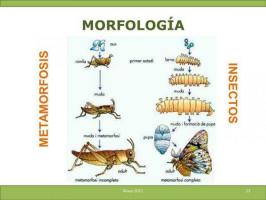ANNELIDS: types, characteristics and examples
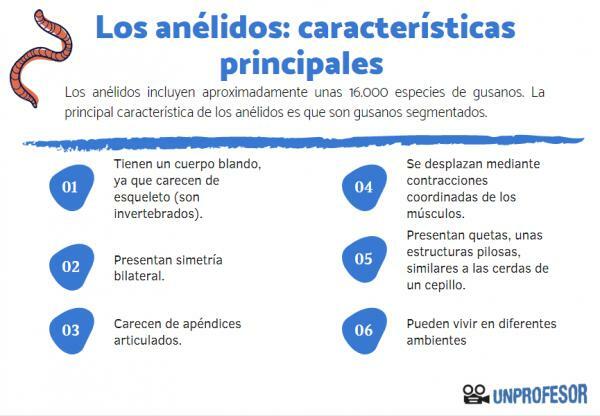
In nature we can meet many worm-shaped animals, but not everything is the same. Within what we normally call worms, we can find mainly the annelids, flatworms and nematodes. Although they may seem difficult to differentiate, annelids usually have their bodies divided into rings, while flatworms are called flatworms and nematodes are flatworms. In this lesson from a TEACHER we will review the annelids: types, characteristics and examples of each of the classes.
Index
- Annelids and their main characteristics
- Types of annelids
- Polychaetes: Characteristics and Examples
- Oligochaetes: Characteristics and Examples
- Hirudíneos: Characteristics and examples
The annelids and their main characteristics.
The annelids include approximately a few 16,000 species of worms. The main characteristic of annelids is that they are segmented worms, that is, its body is made up of numerous similar metamers or rings. This segmentation is not only external, but also internal: certain organs are repeated in each of the segments (they have, for example, a pair of nerve ganglia in each segment).
Main characteristics of annelids
The important characteristics of annelids are:
- They have a soft body, since they lack a skeleton (they are invertebrates).
- Present symmetry bilateral.
- Lack of appendices articulated.
- They move by contractions coordinated muscles.
- They present quetas, hairy structures, similar to the bristles of a brush. They help them to move and, in some species, they can also have a tactile function
- They can live in different environments: salt water (nereis), fresh (leeches) or in damp soil (earthworms)
- They have forms of life: free, fixed (attached to the bottom of the sea or rocks) or parasitic (leeches).
- They have variable sizes, from millimeter shapes to several meters in length.
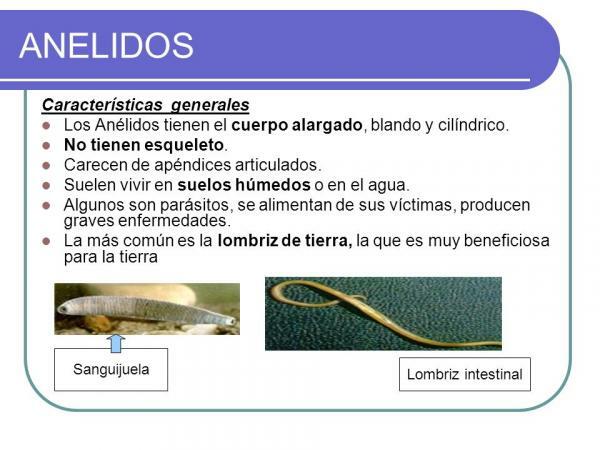
Types of annelids.
Annelids are classified into three groups, taking into account the number of quetas and the environment in which they live, mainly:
- Polychaetes: They are marine annelids with many quetas.
- Oligochaetes: They are terrestrial and freshwater annelids with few quetas.
- Hirudineans: They are annelids, without quetas and with suckers, that come in fresh water or are parasites.
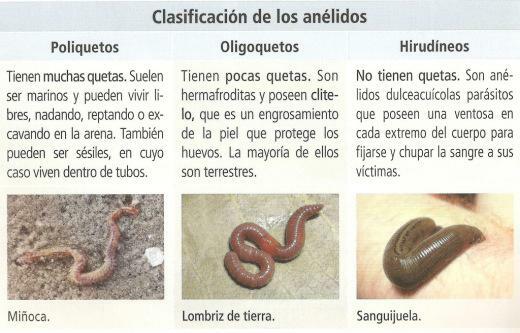
Image: Fauna and ecosystems information
Polychaetes: Characteristics and examples.
Polychaetes are aquatic animals, almost exclusively marine, that have a parapod on each side in each segment. Many quetas emerge from these parapods, which gives the group its name. The best known polychaetes are the group of the nereis.
Other characteristics of polychaetes are:
- In addition to parapods they usually have appendages and eyes
- Variety feeding: there are species carnivorous, but others filter sediment or water.
- Varied habitat: there are free-living polychaetes (like the Nereis or the Philodocids), they dig galleries in the sand (Arenicola marina) or are water filters (ex: sea dusters).
- Sexual reproduction: both wandering and free-living polychaetes have sexual reproduction, with well-differentiated individuals of the two sexes (sexual dimorphism).
Polychaetes are classified according to their type of life in two groups: wandering and sedentary. Within the wandering polychaetes we find all those who actively move while the sedentary are all those who do not move, whether they are filter feeders, excavators, tubiculturals, etc.

Image: Slideplayer
Oligochaetes: Characteristics and examples.
Oligochaetes are the group of annelids more simple. The best known group of oligochaetes are the Earthworms. Unlike polychaetes, oligochaetes do not have parapods, other appendages, or eyes. Other important characteristics of the group are:
- Very small and scarce quetass, practically invisible to the naked eye.
- Very varied lifestyles: the vast majority of oligochaetes are terrestrial, but there are also marine and freshwater oligochaetes and some parasitic groups.
- Sexual reproduction with hermaphroditic individuals: They are hermaphroditic but to reproduce they need another individual since they are not capable of self-fertilization.
- Very varied diet: they are decomposers (such as tubifex, which inhabit the seabed), filter feeders (Agriodrilus spp) or predators (Phagodrilus)
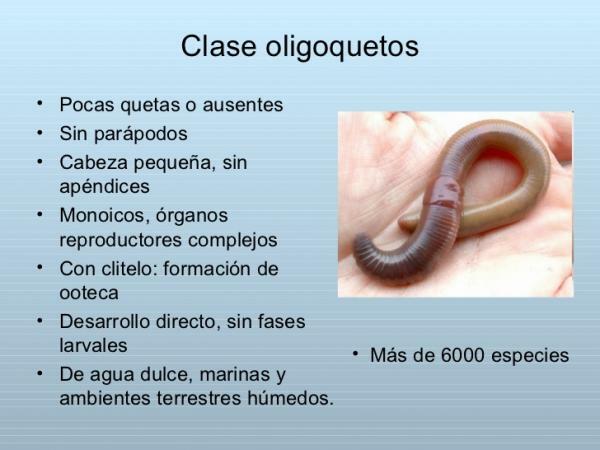
Image: Slideshare
Hirudíneos: Characteristics and examples.
Hirudines are annelids that they lack eyelets and eyes. The great acquaintances are the leeches, which are characterized by feeding on the blood of blood and have been traditionally used in medicine to alleviate the accumulation of blood in surgical interventions or the elimination of certain poisons in the blood.
The Hirudineans have the following general characteristics:
- Habitat: There are marine and terrestrial hirudines (giant red leech, Mimobdella buettikoferi), but the vast majority of species are freshwater. Some arboreal species have also been described (Haemadipsa sylvestris), although they are very rare.
- Feeding: Most predatory (Erpobdella octoculata) and some parasites. Hematophagous species, temporary ectoparasites that feed on the blood of other animals (Hirudo medicinalis; Mimobdella buettikofer).
- Reproduction: Sexual with hermaphroditic individuals.
- In some cases they have a pharynx that can extend to the middle (evaginable) and a mouth with or without jaws.
In parasitic species, the jaws make small cuts and a substance is released anesthetizing and anticoagulant, which makes the parasitized animal not notice the cut and not the blood do not clot. Predatory species evacuate their pharynx to feed on animals that can be as large as they are.

Image: Slideshare
If you want to read more articles similar to Annelids: types, characteristics and examples, we recommend that you enter our category of biology.
Bibliography
- Mena Bayón, J (August 5, 2015) Characteristics of annelids. Recovered from: http://encina.pntic.mec.es/~nmeb0000/invertebrados/anelidos/anelidos2.html
- Vera, K., Blu, F., & Torres, H. (2005). Leeches, parasites present yesterday and today. Chilean Journal of Infectology, 22 (1), 32-37.
- EcuRed (s.f) Annelids. Recovered from: https://www.ecured.cu/An%C3%A9lidos


